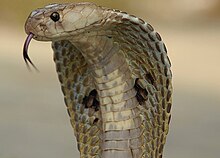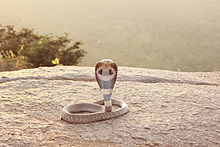Cobra


Cobra (/ˈkōbrə/ ⓘ) is the Portuguese word for "snake". In English and in some other languages, it has been adopted as the name for any of various species of venomous snakes. Most of those species are in the family Elapidae, all of which are venomous. Most of them can spread their neck ribs to form a flattened, widened hood.
Not all snakes commonly referred to as cobras are of the same genus, or even in the family Elapidae. The name "cobra" is short for cobra de capelo or cobra-de-capelo, which is Portuguese for "snake with hood", or "hood-snake".[1] In some modern languages, such as Afrikaans, the other part of the Portuguese name was adopted, and the predominant name for a cobra in Afrikaans is kapel.[2][3] When disturbed, most of these snakes rear up and spread their necks (or hoods) in a characteristic threat display, making them a favorite of snake charmers because of the dramatic effect. Long ago, snake charming was a religious ritual, though now it has become entertainment. Cobras, which may live up to 20 years, are found from southern Africa, through southern Asia, to some of the islands of Southeast Asia.
Cobra may refer to:
- Naja, also known as typical or "true" cobras (known for raising the front part of the body and flattening the neck in a warning signal when alarmed), a group of elapids found in Africa and Asia. They include over 20 species, including Naja nivea, the Cape cobra, a moderately sized, highly venomous cobra inhabiting a wide variety of biomes across southern Africa; Cleopatra's "asp" (the Egyptian cobra, Naja haje); and the Asiatic spectacled cobra Naja naja and monocled cobra, Naja kaouthia.
- Spitting cobras, a subset of Naja species with the ability to squirt venom from their fangs in self-defense
- Hemachatus haemachatus, ringhals, rinkhals or ring-necked spitting cobra, a species of the Elapidae found in Africa
- Any member of the genus Boulengerina, the water cobras, a group of Elapidae found in Africa (now regarded as species in the genus Naja)
- Paranaja multifasciata, the burrowing cobra, an African species of the Elapidae (now regarded as a species of Naja)
- Any member of the genus Aspidelaps, the shield cobras,[4] an African genus in the Elapidae
- Any species of Pseudohaje, the tree cobras, a genus of African Elapidae
- Ophiophagus hannah, the king cobra, an elapid found in parts of India and southern Asia
- Micrurus fulvius, the American cobra or eastern coral snake, a species of the Elapidae found in the southeastern United States and in parts of Cuba.
- Hydrodynastes gigas, the false water cobra, a mildly venomous member of the family Colubridae, is indigenous to parts of South America and forms a hood if disturbed, though the hood is longer and narrower than those of "true" cobras in the Elapidae.
- Not a common name, but a highly obsolete synonym for the genus Bitis, the adders, a group of venomous vipers found in Africa and parts of the Middle East
Most so-called, and all "true", species of cobras belong to the family Elapidae. Many other notoriously venomous snake species, including mambas, sea snakes, and coral snakes, also belong to the Elapidae. The genus Naja contains over 20 species of cobras and is the most widespread and widely recognized genus of cobras, sometimes called the "true" cobras. Members of the genus inhabit a range from Africa through the Middle East, India, and Southeast Asia to Indonesia.
Although the king cobra, Ophiophagus hannah, the world’s longest venomous snake, is a member of the Elapidae and can raise a rather narrow hood if disturbed, it is not in the genus Naja, and, accordingly, is not a true cobra.
The other cobra of Asia is known as the Asian, Indian, or spectacled cobra (Naja naja) due to the eyeglass-shaped pattern on its skin. The hood of the Asian cobra is larger than that of the king cobra and is usually yellow or brown with a black and white spectacle pattern on top and two black and white spots on the lower surface, although albino specimens are also found.[5]
The rinkhals, Hemachatus haemachatus, also called a spitting cobra, is endemic to southern Africa. It also is not in the genus Naja.
Although the bites of some species are extremely dangerous because of their potent neurotoxins, cobras have not been shown to attack people unprovoked. Cobras almost never attack without a threat display, which typically involves raising the hood and hissing.[citation needed]
Various species of cobras prey mainly on other snakes, birds, and small mammals, while their main natural predators in turn are other snakes, birds of prey, and small predatory mammals such as mongooses. [citation needed]
Although most cobras do not make nests, some species protect their eggs until they hatch (incubation typically taking around 60 days).[citation needed]
References
- ^ Oxford. 1991. The Compact Oxford English Dictionary. Second Edition. Clarendon Press, Oxford. ISBN 0-19-861258-3.
- ^ Boshoff, S. P. E.; Nienaber, G. S. (1967). AfrikaanseEtimologieë. Pretoria: Die Suid-Afrikaanse Akademie vir Wetenskap en Kuns.
- ^ Bosman, D. B.; Van der Merwe I. W.; Hiemstra, L. W. (1984). Tweetalige Woordeboek Afrikaans-Engels. Tafelberg-uitgewers. ISBN 0-624-00533-X.
{{cite book}}: Unknown parameter|lastauthoramp=ignored (|name-list-style=suggested) (help) - ^ Broadley, Donald G.; Andrew S. Baldwin (2006). "Taxonomy, natural history and zoogeography of the Southern African shield cobras, genus Aspidelaps (Serpentes: Elapidae)" (PDF). Herpetological Natural History. 9.
- ^ Rylah, Juliet Bennett (4 September 2014) "Albino Cobra Continues Its Suburban Reign Of Terror". Los Angeles Cityzine – Your City – Your Cityzine.
